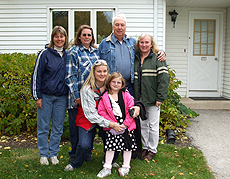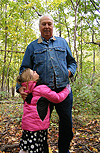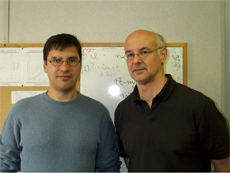|
Thursday, Oct. 30
THERE WILL BE NO PHYSICS AND DETECTOR SEMINAR THIS WEEK
2:30 p.m.
Theoretical Physics Seminar - Curia II
Speaker: Lisa Randall, Harvard University
Title: Flavor Physics from Warped Geometry
3:30 p.m.
DIRECTOR'S COFFEE BREAK - 2nd Flr X-Over
4 p.m.
Accelerator Physics and Technology Seminar - One West
Speaker: Paul Derwent, Fermilab
Title: The ICD, a First Step Towards the Intensity Frontier
Friday, Oct. 31
10:30 a.m.
Research Techniques Seminar - Curia II
Speaker: Harry van der Graaf, NIKHEF
Title: GridPix/Gossip
3:30 p.m.
DIRECTOR'S COFFEE BREAK - 2nd Flr X-Over
4 p.m.
Joint Experimental-Theoretical Physics Seminar - One West
Speaker: Kendall Mahn, Columbia University
Title: MiniBooNE Muon Neutrino and Muon Antineutrino Disappearance Results
Click here for NALCAL,
a weekly calendar with links to additional information. |
|
Thursday, Oct. 30
- Southwestern chicken tortilla
- Philly style cheese steak
- *Garlic herb roasted pork
- Smart cuisine: Mardi Gras jambalaya
- *Southwestern turkey wrap
- Assorted sliced pizza
- *Marinated grilled chicken caesar salads
*Carb restricted alternative
Wilson Hall Cafe menu |
|
Thursday, Oct. 30
Dinner
- Closed
Wednesdsay, Nov. 5
Lunch
- Chicken marsala
- Carrots with garlic and rosemary
- Rum pecan cake
Chez Leon menu
Call x4598 to make your reservation. |
|
|
Four generations visit old prairie home

All four generations of the Malone family stand in front of John Malone's old house on the Fermilab site. Pictured from left: Robin Simmons, Kathy Elstrom, Kelly Pedersen, Payton Pederson, John Malone and Teri Schramer.
From Kirk Road, John Malone can spot a blue spruce tree his mother planted decades ago.
"I was just a little shaver then," Malone said.
Last week Malone, 68, brought four generations of his family to the laboratory to visit the home where he grew up. Fermilab Roads and Grounds employee Bob Lootens, whose family also owned land on the property, even treated the Malone family to a trek through shoulder-high prairie grass to the house's original site.
"This is where grandpa was born and raised," Malone said to his great-granddaughter, Payton, 5, as he looked across the field. "Sure looks different. This was all nicely mowed and beautiful. We had a big fence with thick boards and posts painted a different color every year."
Every year, Malone travels to Fermilab from Missouri for the Farmers' Picnic, where he reunites with former neighbors. But this was the first time in more than 20 years he had visited the original site of his old house, which has been relocated to 6 Sauk Road and now serves as temporary housing.
 |
| John Malone and his great-granddaughter, Payton. The Malone family visited Fermilab earlier this month to see their former family home. |
Malone's three daughters remember visiting their grandmother at the house when they were young.
"I remember more outside than I do inside, but it was really weird when I walked in," said Malone's daughter Robin Simmons, 44. "I was extremely emotional for a second."
Malone's daughter Kathy Elstrom, 48, filmed as she walked through the house with her father, sisters, daughter and granddaughter to document the family's history.
Malone said he remembers watching movers transport the house across the fields. Today, only the blue spruce, a patch of lilacs and the old frames of a swing set and a seesaw remain to mark the spot where Malone grew up.
"It's just nice of (Fermilab) to bring us back here," Malone said.
-- Kathryn Grim
|
Ultramassive: as big as it gets
From Science News, Oct. 25, 2008
A black hole can consume anything in its path. These monsters can become huge - but perhaps only so huge.
If asked to name stupendously amazing things in space, most people would probably pick black holes. These evil-tinged clowns of the universe are definite wows. Insatiable is their middle name.
Grand and merciless, voracious and monstrous, pure appetite and deep mystery. The biggest fatten themselves in galaxy cores mainly via a seemingly limitless hunger for a main source of sustenance: fat, circular wads of gas that gather around the black holes and are sometimes given a name to delight any glutton, Polish doughnuts. Black holes cloak their innards behind an "event horizon," from inside which no message can be sent (which explains the one-liner physics joke: "Two protons walk into a black hole").
What a parade of jaw-droppers that is. Well listen up, this just in: It looks like there is a limit to the superlatives. Black holes can't eat everything. If a new analysis from a Yale astronomer is correct, even black holes run out of steam, and at a fairly precise point. The biggest black holes may reach only a few tens of billions of times the mass of the sun.
To be sure, that's huge. Most galaxies harbor central black holes of a few million solar masses (about 4 million for the Milky Way). Fifty million light-years away in Virgo, the giant elliptical galaxy M87 is believed to harbor one having about 3 billion solar masses. The record heft for a suspected black hole, 3.5 billion light-years away and part of a double-black-hole system with a partner's orbit that reveals its mass with some precision, is 18 billion solar masses.
Any possible cap on the size of these monsters occupying galactic centers shouldn't diminish the place of black holes in popular imagination. And for astronomers, the newly proposed mass limit illustrates how the status of black holes, as both scientific challenge and principal player in the universe's appearance, is on the rise.
Astrophysicists and cosmologists thought they had black holes pretty well pegged about 10 years ago. Black holes eat, they grow and they can sure produce a bright light from X-ray to radio wavelengths while on a binge. Their quasar-pumping conversion of matter to outward-beamed energy as they consume gas, dust and the occasional unlucky star is believed to reach about 40 percent efficiency. It's not only E=mc2 at which black holes excel. They also provide wonderful playgrounds for a panoply of other Einsteinian gymnastics. They bend time, warp space and, along their borders, they spawn a fizz of evanescent virtual particles popping in and out of space's fabric.
Read more
|
|
|
The purest tops

This plot shows the number of tagged jets per event for the selected top pair candidate events. The good agreement between the data and simulation reaffirms our understanding of the properties of the top quark. The bins with one or two b-jets are very pure top events with virtually no background. The measured top quark pair cross section, with 162 candidate events, is 6.7 ± 0.8 (stat) ± 0.4(syst)± 0.4 (lumi) picobarns for an assumed top quark mass of 175 GeV/c2.
Top quark pairs have been mined for a decade by scientists at Fermilab, which is still the world's only top quark factory. Since the observation of the top quark in 1994, physicists have been mystified by its extremely heavy mass. This has led many scientists to believe that the top quark may shed much-needed light on the path to new physics.
Scientists at CDF recently measured the top quark pair production cross section in the purest of the channels, the so-called dilepton channel. Using 2.7 inverse femtobarns of Tevatron data, the researchers find the result consistent with the latest measurements in other decay modes.
Top quarks are known to decay close to 100 percent of the time to a W boson and a b-quark. The dilepton channel is the mode in which both W bosons decay to a lepton and a neutrino. This channel has the highest purity.
Scientists selected this dilepton sample in the CDF data by requiring at least two jets (from the b-quarks), large missing transverse energy (from the neutrinos) and two leptons (electrons or muons).
In these selected events, the fraction of events coming from the different leptons flavors (electrons of muons) was found to agree with expectation and provide a rigorous test of essential top quark behavior.
The number of events that contain at least one tagged jet (a jet with an identified displaced vertex) is also associated with top quark decays. This indicates the presence of a b quark, thus further reducing the backgrounds. When scientists require at least one tagged jet the constraint halves the sample size and produces an extremely pure signal with a signal-to-background ratio of 15. By requiring both jets to be b-tagged, scientists get a sample of 18 events, none of which are from background processes. These are the purest observable top-pair events. In contrast, in the lepton + jets channel with one tagged jet, scientists observe only about three signal events for each background event.
To find out more about the measurement visit the analysis page

The main authors of this analysis are Alexei Varganov (left) and Dan Amidei (right) both from the University of Michigan.
|
|
Have a safe day!
Traffic safety poster contest for kids
The Traffic Safety Subcommittee is sponsoring a traffic
safety poster contest for fourth and fifth grade
students of Fermilab employees, users and contractors. The
posters should promote increased traffic safety awareness.
Entries are due Oct. 31. The contest winner will be announced in
Fermilab Today. The top posters will be displayed in the Wilson Hall atrium. For more information and an entry form, click here.
Change clocks, batteries in smoke detectors Saturday
The Fermilab Fire Department would like to remind everyone that Daylight Saving Time ends this weekend. When changing your clocks back this Saturday, Nov. 1, remember to replace the batteries on your smoke detectors and CO detectors. This is also the perfect time to test your smoke detectors to make sure they are working properly. If you have any questions regarding fire safety, please feel free to contact the fire department at x3428.
International Folk Dancing Oct. 30
International Folk Dancing will meet Thursday, Oct. 30, at Kuhn Village Barn for its annual Halloween party. Dancing begins at 7:30 p.m. with teaching and children's dances earlier in the evening and request dancing later on. Newcomers are welcome and you do not need to come with a partner.Costumes and treats are welcome! For more information, call (630) 584-0825 or (630) 840-8194 or e-mail folkdance@fnal.gov.
Exciting Explorations! child care program offered
Exciting Explorations!, a child care program for children ages 7-12, will take place Nov. 24, 25 and 26, depending on interest. A summer camp counselor will lead the program, Two snacks and beverages are provided. Please send a sack lunch. Program cost is $25 a day and payment is due upon reservation. Reservations are due Nov. 19 for the November dates. To register or for more information, contact Mary or Patti in the Children's Center at x3762 or e-mail daycare@fnal.gov.
Additional Activities
|
|